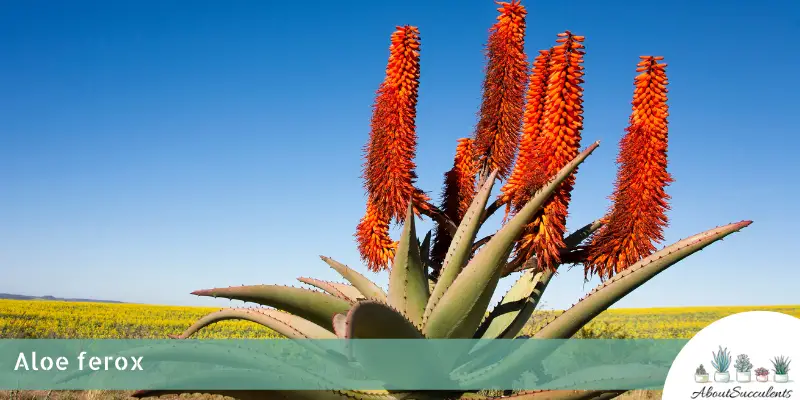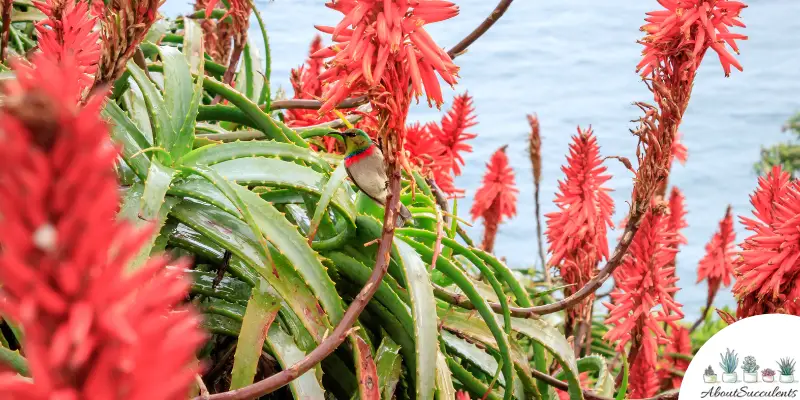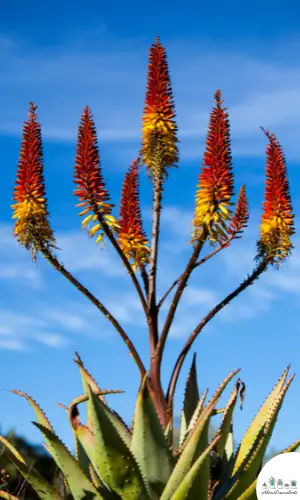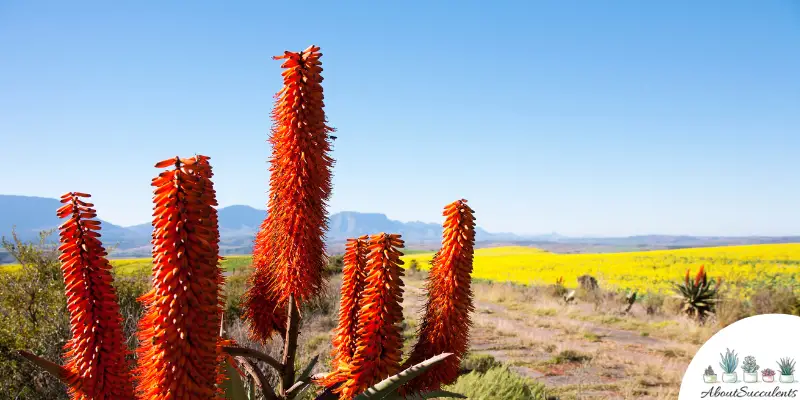
Aloe ferox is a tall single-stemmed succulent that can reach a height of 10-feet (3m). It’s identifiable by its long, thick, and fleshy dark-green colored leaves that have reddish-brown colored spines along their edges.
Smaller spines can be found on the leaves’ upper and lower areas. The leaves grow into curling rosettes that are both intimidating and majestic at the same time.
While young, the surfaces of the leaves of Aloe ferox are covered with spines. However, as the succulent matures and grows taller, it loses most of its spines except for those that mark the edges of the leaves.
Aloe ferox is known by many names – Cape Aloe, Red Aloe, and Tap Aloe – but the most commonly used alias is Bitter Aloe.
In the Fall, Bitter Aloe will produce bright reddish-orange flowers with brown-colored tips on their inner segments. These flowers are compact and symmetrical and grow into 8 cylindrical racemes that measure 19-inches (50cm) to 31-inches (80cm) in height.
The combination of the bright orange flowers standing 2-feet (60cm) to 4-feet (120cm) above the spindly, long, dark green leaves make Aloe ferox a sight to behold in any outdoor succulent garden.
Aloe ferox is native to South Africa. It’s part of the genus Aloe and is a member of the Asphodelaceae family.
General Information
Also known as: Bitter Aloe, Cape Aloe, Red Aloe, Tap Aloe
Plant Family: Asphodelaceae
Origin: South Africa
Height: 10-feet (3m)
Exposure: Partial to full sun for up to 6 hours per day.
Water Needs: Drought-tolerant; use the “Soak and Dry” method for watering
Soil Type: Cactus soil or a succulent mix with 50% added gritty materials such as perlite, pumice, bark chips, lava rock, and coarse sand. A little amount of peat moss will improve moisture content.
Soil pH: 5.5 to 8.5
How to Grow and Care for Aloe Ferox

Aloe ferox is popular among plant hobbyists for four reasons. First, it makes every garden stand out with its imposing, yet sublime appearance. Second, Bitter Aloe is durable against drought conditions. It can survive weeks without water.
Third, studies have shown that compared to other varieties of Aloe, Cape Aloe’s leaf extract contains the highest levels of anti-inflammatory and analgesic properties.
Lastly, Aloe ferox, despite its size, is easy to grow and care for. This tall, spiky succulent will look great on xeriscaped yards or in a rock garden. Indoors? Yes, but if you have pets, keep them away from Bitter Aloe.
Sunlight
Aloe ferox needs plenty of sunlight. If you’re growing Tap Aloe in your garden, plant it in a location where it can get up to 6 hours of sunlight a day. Avoid the afternoon sun as its scorching rays will burn the leaves.
As a houseplant, place the container near a window that gets 4 to 6 hours of partial sunlight. Also, make sure the room where Cape Aloe is located has good air circulation. Damp and humid environments are ideal conditions for the leaves to develop disease-causing molds.
A good argument for growing Cape Aloe indoors is that it isn’t a cold-hardy succulent. If the temperature in your area drops below 20° F (-6.7° C), plant Tap Aloe in a container that you can move indoors.
Watering

Aloe ferox stores a lot of water in its leaves and stems. Like many varieties of succulents, Bitter Aloe can survive without receiving water for weeks.
In contrast, watering its soil frequently or while it still contains moisture might lead to Aloe ferox’s bitter end. Overwatering is the leading cause of succulent death.
If you water the soil too often, the roots will rot. Moistened soil also breeds fungus that can enter the plant via the rotted roots. The best approach to water succulents is the “Soak and Dry” method.
First, insert your finger or a stick an inch deep into the topsoil. If the end of the stick feels dry – move on to step 2 – giving the soil a good soaking.
During summer or spring, you might only water Bitter Aloe every seven to 10 days. Come wintertime, you’ll only water the soil once a month.
Pot and Soil
The best pot for Aloe ferox is one that’s made of unglazed ceramic or terracotta because these materials are highly-absorbent and help remove excess moisture from the soil.
Before buying the pot, check and make sure that the bottom has a large enough drain hole to filter out excess water.
Drainage remains the top priority for choosing the best soil for Aloe ferox. You can use a cactus mix or potting soil that’s developed for succulent plants. Add 50% gritty materials such as perlite, pumice, coarse sand, bark chips, and lava rocks.
These gritty materials create tiny air pockets that enable the roots to receive more oxygen while at the same time, expediting drainage.
You might want to add peat moss to the soil mix because Aloe plants do well with a bit more moisture in the soil.
If this seems contradictory to the need to improve drainage, it’s just a matter of balancing out the level of moisture and removing excess water. A little bit of peat moss won’t offset the drainage properties of the gritty materials.
How to Propagate Aloe Ferox

If you want to multiply the number of Aloe ferox in your outdoor garden, there are 2 methods you can use to propagate the species: Stem cuttings and seeds.
Stem Cuttings
Step 1: With a sterilized and sharpened knife, cut off a small section from the stem.
Step 2: Allow the stem cuttings 2 to 4 days to grow calluses.
Step 3: Place the calloused stem cuttings on well-draining soil.
Step 4: Lightly water the soil and move the pot near a window that gets up to 6 hours of sunlight per day.
Step 5: Once the roots have fully formed, only water the soil when it has gone dry.
Seeds Method
Step 1: Plant the seeds in well-draining soil. If the temperature is warm, you can plant the seeds outdoors. However, once the weather gets cold or below 20°F to 25° F (-6.7° C to -3.8° C), it would be best to plant the seeds indoors.
Step 2: Lightly water the soil and place it in a location where it can get up to 6 hours or partial or full sun. Another option is to place the pot under a Grow Light or to use a Seed Mat.
Step 3: Germination might take time. But once the roots have formed, use the “Soak and Dry” method for watering the soil.
Frequently Asked Questions
Is Aloe Ferox Toxic to Cats and Dogs?
The genus Aloe is included in the list of plants that are toxic to cats and dogs on the website of the American Society for the Prevention of Cruelty to Animals (ASPCA).
If you still prefer to grow Aloe ferox indoors, keep your pets away from it. Not only can they get sick from ingesting the sap but the spines that cover the leaves can be harmful to them.
Why is my Aloe Ferox Dying?
Other than overwatering, Aloe ferox can get sick and potentially die if infested by pests such as snout beetle, mealybugs, aphids, and other scale insects.
Overwatering
You can be sure that Bitter Aloe’s roots have rotted and that infection has taken place if the leaves look discolored and mushy.
To save Cape Aloe, remove the infected sections of the leaves and stems with a sharpened and sterilized knife or garden shears. By doing so, you will prevent the infection from spreading further.
After you’ve removed the infected sections of the leaves, do the same with its roots.
While Tap Aloe is resting, fill up a new pot with fresh cactus soil. Repot Aloe but don’t water the soil right away. Give the succulent 2 to 3 days to acclimatize to the soil before watering.
Pest Infestation
Pests eat the succulent’s leaves and drink their sap. Not content with feasting on Aloe ferox, these pests will leave waxy substances that can contaminate your plant.
Use a mild or diluted insecticide such as neem oil to protect Cape Aloe from pests. You can use the fungicide or a cotton ball soaked in 70% isopropyl alcohol to remove the waxy substances on the leaves.
Yes. Bitter Aloe will produce bright reddish-orange flowers with brown-colored tips on their inner segments in the Fall months.
Last Updated on June 9, 2022 by Sofia Lara